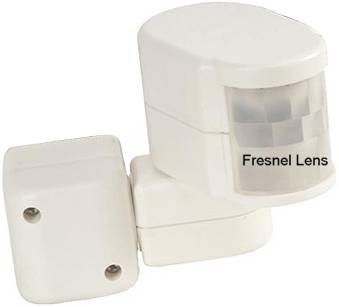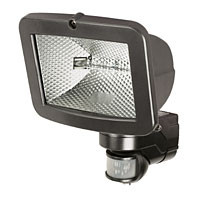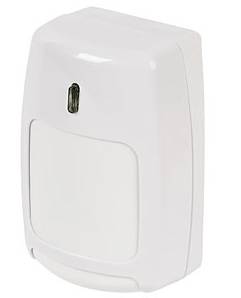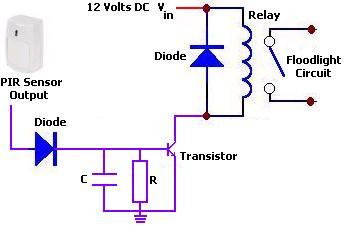Passive Infrared Detectors

At the front of a PIR sensor unit is a fresnel lens (pictured above). This special kind of lens is used to gather light from a very wide field of view and focus it directly onto a passive infrared sensor (as shown below).

Some electronics inside the PIR sensor unit then decide whether the infrared light detected is from a warm moving body, and if so, triggers a switch.
Uses for PIR Sensors

* The duration the light is left on for can usually be set by the user.
Such PIR security lighting systems are available from a wide range of sources from as little as £10.00 up in the UK.
PIR Sensors and Renewable Energy
The vast majority of commercial PIR sensor products are built to run on 240 VAC mains electricity. This makes them unsuitable for most renewable energy powered systems such as motion activated CCTV systems in remote locations. Although a power inverter can be connected to the RE system battery bank to obtain the necessary voltage, using it for 24 hours per day for such as small load would be a huge waste of energy.
Fortunately 12 Volt DC powered PIR sensor units are available. These (such as this 12V PIR sensor available in our REUK Shop and pictured above) can be connected directly to a 12V battery or battery bank, and used to trigger a Relay when motion is detected. The relay will switch on/off a light or any other 12VDC or even 240VAC device if required.
If a power inverter is necessary to power a 240 Volt device switched on by the PIR sensor, then the inverter can also be turned on as and when required rather than needing to leave it on 24 hours per day. This saves a considerable amount of energy.
This PIR sensor will run off 10-14 Volts DC electricity and draws a current of under 10mA.
PIR Sensor Timer Circuit
12 Volt PIR Sensors do not usually include a built-in timer. Therefore, it is necessary to put together a very simple circuit so that whatever device is connected to the PIR sensor will stay switched on for the desired length of time.
The circuit shown above will turn on a floodlight or other device for a time in seconds approximated by the value of the capacitor C (meaured in microFarads) multiplied by the resistor R (measured in megaOhms) multiplied by 0.75.
For example, if R = 1M and C = 22uF, the floodlight would remain lit for around 16 seconds after the PIR sensor switched off.
Weaknesses of PIR sensors
In order for a PIR sensor to work well most of the time, they are designed with certain limitations. A PIR sensor cannot detect a stationary or very slowly moving body - if the sensor was set to the required sensitivity, it would be activated by the cooling of a nearby wall in the evening, or by very small animals. Similarly, if someone walks straight towards a PIR sensor, it will not detect them until they are very close by.PIR sensors are temperature sensitive - they work optimally at ambient air temperatures of around 15-20 degrees Celcius. If the temperature is over 30 degrees, the field of view narrows and the sensor will be less sensitive. Alternatively, if the temperature is below 15 degrees, the field of view widens and smaller or more distant objects will activate the sensor.
http://www.reuk.co.uk/PIR-Sensors.htm